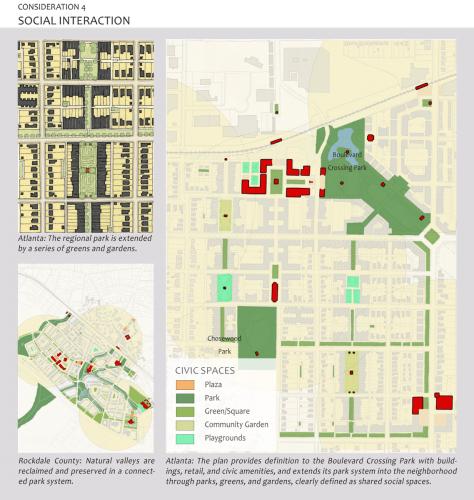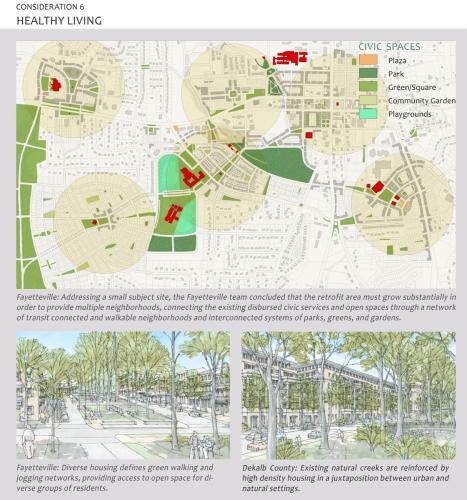
Lifelong Communities

Location: Atlanta, Georgia, USA. Community, transit-oriented, infill and greenfield development and improvement
Project Description
This community (Retrofit initiative is a comprehensive effort to help the Atlanta metro area respond to an aging population and its diverse needs. This Retrofit Charrette was initiated on the premise that is is not possible to meet the needs of the growing older population with supportive programs or innovations in healthcare alone, but rather requires rethinking the way we plan for and regulate the built environment. The Charrette brought together healthcare, aging, mobility, transportation, accessibility, architecture, planning and design experts to explore the challenges of creating Retrofit Communities in the largely suburban landscape where most baby boomers live. The Charrette team was asked to address these specific challenges:
Local officials, planners and developers need concrete examples of what Retrofit communities look like and how design principles can shape them. The region needs practical ideas for better integrating housing and transportation alternatives, retail and health services into neighborhoods.
retrofit communities challenge existing development patterns and regulations. While many community groups and professions acknowledge that change is needed, accepting and approving plans that reflect new ways of organizing communities is hard to do. The metropolitan planning organization needs to build momentum in the region to imagine how the different goals of a Retrofit Community can be realized on the ground.
Even after consensus is achieved, critical decisions about development are often made in ate night planning and zoning meetings. Local officials need simple and direct guidelines for deciding which developments can support the goals of a Retrofit Community and which do not.
The Retrofit Charrette was not intended to develop new specialized forms of age-segregated retirement communities. Rather, it was intended to enforce the notion that aging supports could be dispersed into neighborhood life, provided that the urban structure sufficiently accommodated the eight elements described in the following pages.
Lessons learned: After significant research, study and the development of five conceptual master plans the group came to several central conclusions: Retrofit communities must adhere to the Canon Principles of New Urbanism to truly be places where all people can live throughout their lifetimes. To be fully accessible, from inside the dwelling, down the street and into the restaurant, theater or store, new urban developments must be supported by codes that address accessibility continuously across the entire urban environment. The past century gave humans the gift of longevity, often with the presence of managed disabilities or chronic conditions. Traditional building forms must be modified to reflect the new reality which includes ever increasing life expectancies and varying levels of ability. Conventional, single-use zoning codes and accessibility regulations act as barriers to complete communities. The application of these codes over time without comprehensive regional growth strategies has created an environment that excludes the young, old, and poor. The region and its municipalities must coordinate an effort to retrofit existing communities to serve the needs of their residents through their entire life-cycle.
Transect Zone(s): T1 natural, T3 sub-urban, T4 general, T5 center.
Status: Proposed
Project or Plan's Scale: Region
Features: Bus transit, Civic buildings & parks, Green buildings, Live/work, Mixed uses, Rail/fixed guideway transit, Sustainable infrastructure, Transit oriented development.
Land area (in acres): 364
Total built area (in sq. ft.):
Total project cost (in local currency):
Retail area (in sq. ft.):
Office area (in sq. ft.):
Industrial area (in sq. ft.):
Number of hotel units:
Number of residential units (include live/work):
Civic uses (type and size): Transit stations, civic centers, places of worship, schools, college campuses, learning centers, YMCA, libraries, community gardens, senior centers, "Green House" senior living, etc.
Parks & green space (in acres):
Residential types: Mid-rise/loft, Townhouse/rowhouse/maisonette, Semi-detached.
Project team designers: Duany Plater-Zyberk & Company, LCC
Project team developers: Atlanta Regional Commission (Client)
Previous site status:
Starting/Ending date of construction/implementation: -




